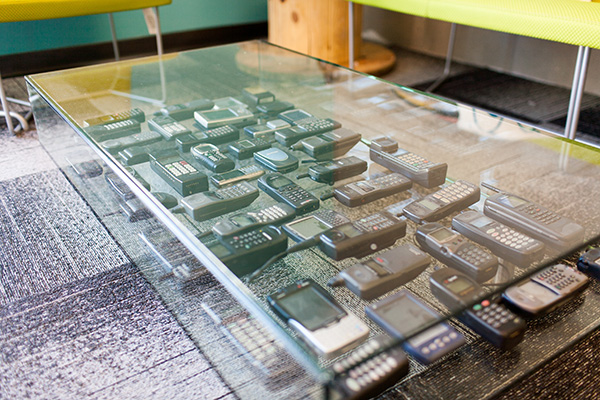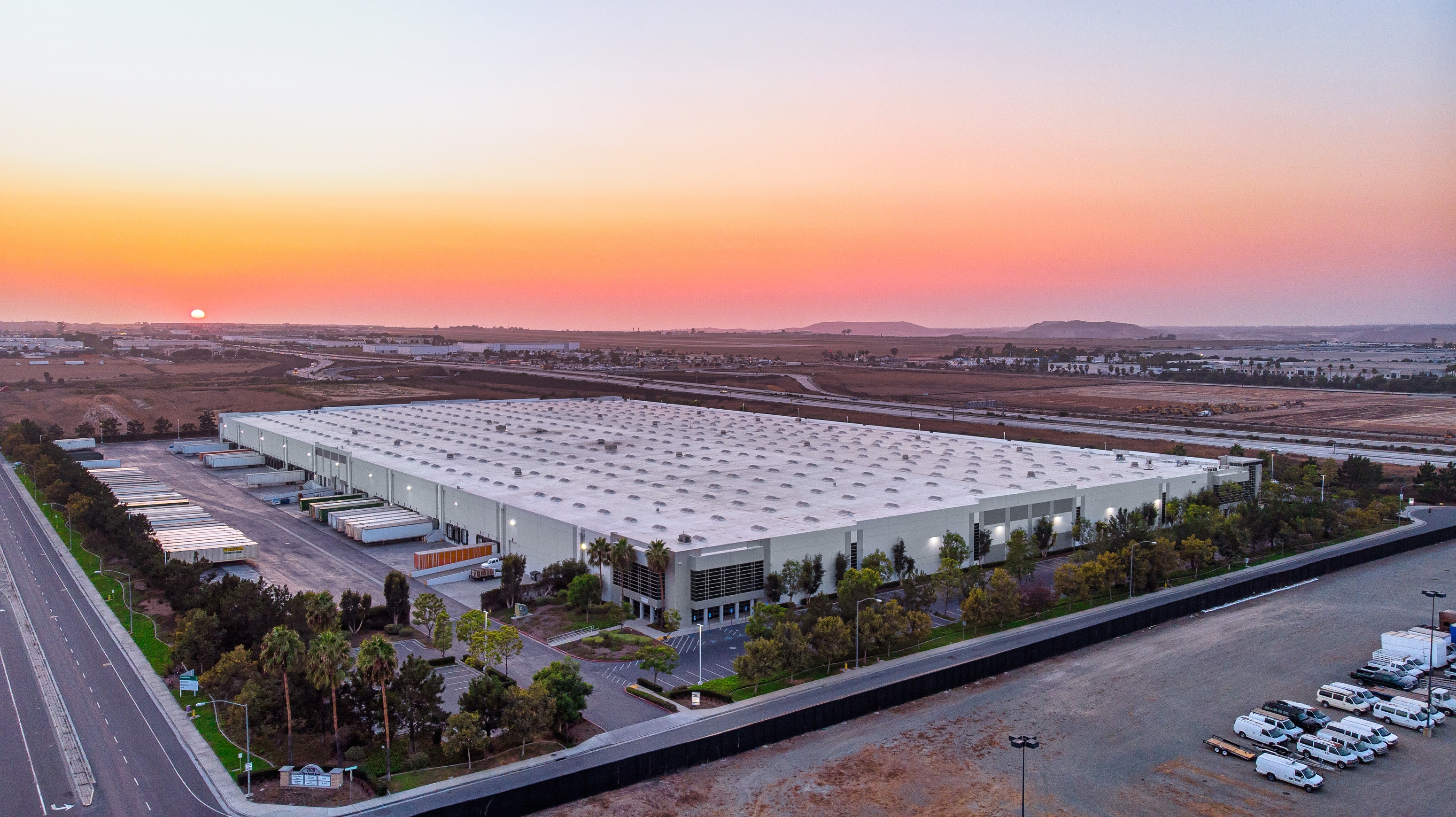Daily Business Report-Dec. 15, 2014
The coffee table at ecoATM’s new corporate headquarters is made up of old cell phones the company has purchased from consumers.
New Headquarters Opened for
San Diego-Born Startup ecoATM
ecoATM, the company that created an automated self-serve kiosk system to buy back old phones, tablets or MP3 players for cash, unveiled its new “environmentally friendly” corporate headquarters in Sorrento Valley on Friday.
The building, located at 1012 Barnes Canyon Road, has more than 53,000 square feet for the nearly 300 full-time employees. ecoATM signed the lease for the building in December 2013.
The San Diego-born startup was founded six years ago in the EvoNexus Incubator, and was one of the first companies to raise money and spin out.
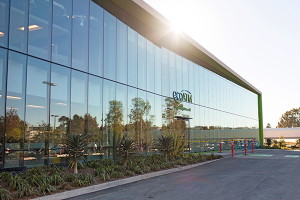
Last year the company was sold for $350 million to Outerwall, a Washington-based public company, which made the commitment to sign a 10-year lease to retain and grow the business in San Diego. A part of that growth plan is the new facility.
The company has paid more than $3 million to residents of San Diego County for their devices through its network of 36 kiosks in the county, which are currently located in Vons and Ralphs locations, malls and a Nexcom Navy Exchange in Downtown San Diego. Nationally, ecoATM has collected three million devices and has 1,510 kiosks.
In San Diego County alone, ecoATM has collected nearly 200,000 devices since 2010 — almost three times the seating capacity of Qualcomm Stadium.
“ecoATM combats the e-waste problem by making electronics recycling easy for consumers — reuse and recycling is a part of our business and has been in our DNA from the start,” said Maria Stipp, president of ecoATM. “Our patented kiosks, device collection milestones, environmental commitments, and now our new building, are perfect examples of putting our brand values into action. Our planned LEED certification underscores ecoATM’s environmental commitment, which extends beyond recycling electronic devices to everything the company does.”
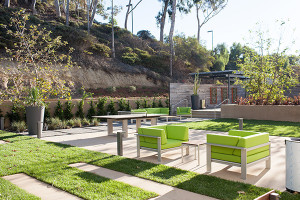
Attending a ribbon-cutting ceremony were building and construction partners from Hughes Marion, Rudolph and Sletten, officials from the Economic Development Corp., Mayor Kevin Faulconer and Congressman Scott Peters. Also attending were Outerwall executives Scott di Valerio, CEO, and James Pinckney, CSO.
***************************************************
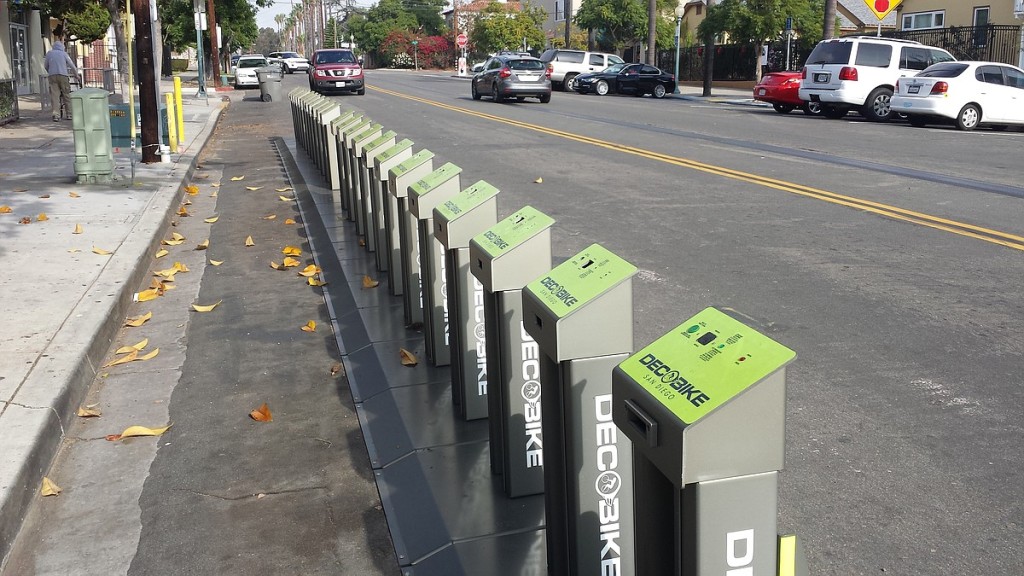
Bike Rental Program Still Not Rolling in San Diego
San Diego’s bike sharing program was supposed to start between January and March of this year. Now it’s December and there are still no bikes to be shared. The program was first delayed until May, then again until August. At the end of the summer, city spokesman Bill Harris said, “station installation should start occurring toward the end of September, and the program should be up and running Oct. 30.”
While stations are popping up around the city, they don’t yet have bikes available for rent. On Friday, Harris wouldn’t answer questions about the delays. He told KPBS to call MJE Marketing, which represents DecoBike, the private company running the city’s bike sharing program.
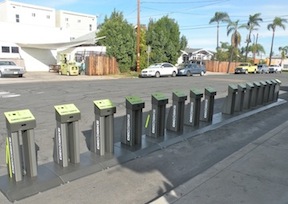
Through an MJE spokesman, DecoBike marketing manager David Silverman issued a statement that said so far 55 stations have been installed in San Diego.
“We plan to have all of the stations in Downtown and uptown installed before activating the system (approx. 75-80 stations),” the statement said. “This should be completed by January 2015. DecoBike now has the most current station location map posted on the website and the membership drive is now live.”
He added that the first 1,500 members to sign up will get a free bike helmet.
The program lets people rent a bike from a checkout station, ride it wherever they want and then return it to any station. Costs range from $7 an hour or $15 a day for a bike to between $20 and $30 a month for an unlimited membership. Its annual membership fee of $99 to $125 is more than other bike-sharing cities, including New York and San Francisco.
In July 2013, the City Council approved a 10-year partnership with DecoBike to supply bikes and set up checkout stations. DecoBike will pay $7.2 million for the bikes and stations and will give the city a portion of its profits — from $1 million to $2.6 million over 10 years.
At the end of April, DecoBike posted a proposed map of stations on its website, which showed them throughout Downtown, Pacific Beach, La Jolla, Hillcrest and North Park, as well as San Ysidro. That map was later taken down and replaced with a new map that showed stations only in Downtown and its immediate surrounding areas. The DecoBike website’s map currently shows only two stations in Downtown.
Harris said in August that the Pacific Beach and La Jolla stations have been “pushed back to another phase.” He said then that the program was delayed because it took longer than expected to work with communities on where to put the bike rental stations.
“There’s a lot of community input, fine tuning, really,” he said. “Really no problems, just they had druthers about some of the spaces rather than the ones that were proposed.”
— KPBS

Southern California Home Sales Fall Sharply
Median Sale Price Holds Steady Again
Home sales in Southern California dropped to the lowest level for the month of November in seven years, the result of a relatively low number of days for recording deals, as well as fewer investor purchases and other market factors, according to CoreLogic DataQuick, a property information service.
There were also more signs of home prices flattening out: The region’s median sale price has changed little over the last three months and November marked the sixth consecutive month in which the median had a single-digit year-over-year gain, following 22 months of double-digit increases.
A total of 15,643 new and resale houses and condos sold in San Diego, Los Angeles, Riverside, Ventura, San Bernardino and Orange counties in November. That was down 18.8 percent from 19,271 sales in October, and down 9.5 percent from 17,283 sales in November 2013, according to CoreLogic DataQuick data.
On average, Southern California sales have fallen 8.4 percent between October and November since 1988, when CoreLogic DataQuick data began. It’s likely that this November’s sales decline from October was especially sharp because of a calendar issue: There were only 17 days on which home sales could be recorded at county recorders’ offices this November, compared with 22 or 23 days in October, depending on the county. Over the last decade, there has been an average of about 19 days for such recordings in the month of November.
“Southern California home sales are closing on a low note in 2014,” said Andrew LePage, data analyst for CoreLogic DataQuick. “Inventory still lags demand in many markets and traditional buyers haven’t filled the void left by the investors who’ve pulled out. Among would-be buyers, affordability and mortgage availability remain as hurdles, as do concerns about job security and the direction of the housing market. But there are reasons to expect more housing demand ahead. According to recent data from the federal government, job and income growth has improved. Many people who became renters after a foreclosure or short sale over the past seven years will want to buy again. And potential home buyers sitting on the fence might be tempted to jump off if they see evidence that mortgage rates will spike from today’s exceptionally low levels.”
The median price paid for all new and resale houses and condos sold in the six-county region in November 2014 was $412,000, up 0.5 percent from $410,000 in October and up 7.0 percent from $385,000 in November 2013. The median hasn’t moved much since September this year, when it was $413,000. The median’s peak for 2014 was $420,000 in August.
Southern California’s $412,000 November median sale price was 18.4 percent below the peak $505,000 median reached in March, April, May and July of 2007. Among the region’s six counties, the November 2014 median in Orange County ($585,000) was the closest — within about 9 percent — to its peak of $645,000 in June 2007.
Foreclosure resales represented 5.3 percent of the Southern California resale market in November. That was up from a revised 4.9 percent in October and down from 6.3 percent a year earlier. In recent months the foreclosure resale rate has been the lowest since early 2007. In the current cycle, foreclosure resales hit a high of 56.7 percent in February 2009. Foreclosure resales are purchased homes that had been previously foreclosed upon in the prior 12 months.
Qualcomm to Invest $40 Million
In Promising Chinese Companies
Qualcomm Inc. announced that it will invest $40 million into four promising Chinese companies and the China Walden Venture Investments LP fund, which is primarily focused on investing in semiconductor or semiconductor-related companies with business in China.
The companies will be funded through Qualcomm’s $150 million strategic China venture fund.
The selected companies were strategically chosen for their innovative work on mobile and wireless technologies:
• 7Invensun focuses on research and development of eye-tracking technology, widely applied in the field of medical and health, virtual reality and movie entertainment, providing a new generation of human-machine interaction experience for enterprises and individuals.
• Chukong Technologies operates an innovative mobile entertainment platform, offering a full suite of solutions and services to enable developers worldwide to efficiently develop, publish and monetize content and providing a highly engaging mobile entertainment experience to users.
• inPlug is a smart home platform solution provider, whose key technology is centered on network virtualization utilizing Software Defined Network, with which comprehensive smart control on home network can be realized. Its current Light Smart Home devices series includes smart plug, smart switch, and infrared control sticker.
• Unisound has launched a series of voice recognition service middleware and platforms, which have been widely deployed in mobile Internet, smart appliance, wearables, on-car navigation, health care, education, and call centers by providing professional voice recognition service to enterprises and consumer users.
“Qualcomm is passionate about innovation and committed to helping advance the Chinese wireless industry,” said Nagraj Kashyap, senior vice president of Qualcomm Ventures. “With a focus on semiconductors, mobile application enablers, smart home and health care, this group of startup companies closely complements existing products and services from Qualcomm Incorporated’s subsidiaries.”
Law Firm Partner Elevated to
San Diego Superior Court Bench
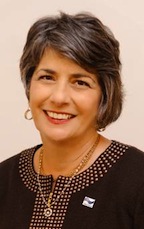
Gov. Jerry Brown announced the appointment of Sharon L. Kalemkiarian to a judgeship in the San Diego County Superior Court. Kalemkiarian, 58, of San Diego, has been a partner at Ashworth, Blanchet, Christenson and Kalemkiarian since 2000. She was an adjunct professor at the University of San Diego School of Law from 2010 to 2014, director of San Diego Project Heartbeat from 1996 to 2000, supervising attorney at the University of San Diego School of Law Child Advocacy Clinic from 1993 to 1996 and a Skadden fellow at the Legal Aid Society of San Diego from 1991 to 1993.
Kalemkiarian served as a law clerk for Judge Gordon Thompson Jr. at the U.S. District Court, Southern District of California from 1989 to 1991. She is a member of the San Diego Regional Water Quality Control Board.
She earned a Juris Doctor degree from the University of San Diego School of Law and a Bachelor of Arts degree from Princeton University. She fills the vacancy created by the conversion of a court commissioner position on Feb. 7, 2014. Kalemkiarian is a Democrat.
The compensation is $184,610.
“I have known Sharon for over 20 years. She has the right temperament, intelligence and experience to be a respected judicial officer,” said Assembly Speaker Toni Atkins, who recommended her appointment to the governor. “I also watched Sharon advance gay rights through her practice. Even before the term ‘marriage equality’ became widely known throughout the nation, Sharon recognized the need for equal treatment in her practice and provided those services to the LGBT community.”
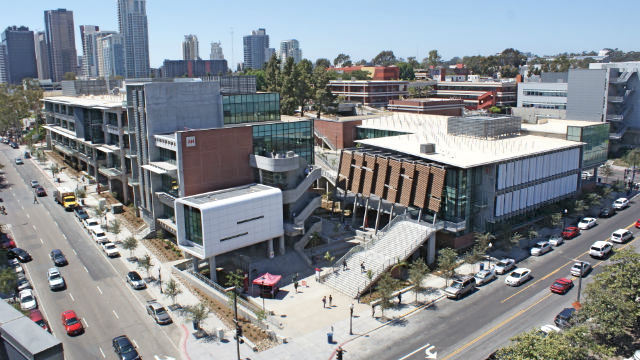
San Diego City College Dedicates
$94.6 Million Building Project
San Diego City College has dedicated a $94.6 million project that brought new buildings for the arts and humanities and business and technology programs to the East Village campus.
The project consists of a 128,000-square-foot, five-story Arts & Humanities building with parking and a student commons, plus a a 62,000-square-foot, three-story Business & Technology building. The two buildings share an open outdoor plaza.
“Thanks to San Diego’s taxpayers, this dual-building project supports an interactive academic environment for students and faculty, and also promotes diverse learning opportunities, socialization, and collaboration through its conjoined open outdoor plaza.” said San Diego Community College District Chancellor Constance Carroll.
The Arts & Humanities building includes new classrooms, a lecture hall, computer labs, and studio space for drawing, ceramics, sculpture, and graphics courses. There is also a 100-seat theater.
The smaller Business & Technology building includes seven computer labs, classrooms, a lecture hall, and areas for student-run start-up businesses.
Both buildings are designed with numerous energy-saving features, and landscaped so as to blend with the surrounding East Village streets.
The project is part of the $1.6 billion Propositions S and N construction bond program approved by taxpayers for City, Mesa and Miramar colleges and seven continuing education campuses throughout San Diego.
— Times of San Diego
Batu Biologics Files Application
For Clinical Trial for Cancer Drug
Batu Biologics, a biotechnology company focused on developing therapies that target the Achilles Heel of cancer — the tumor blood vessels — announced the filing of an Investigational Drug Application (IND) with the U.S. Food and Drug Administration for its lead immune therapy, ValloVax.
Once the IND is approved, Batu Biologics will proceed with a Phase I/II clinical trial for non-small cell lung cancer. ValloVax is a polyvalent cancer vaccine that stimulates an immune response against the tumor-associated blood vessels, seeking to cut off the blood supply required for sustainable tumor growth.
In preclinical testing, ValloVax was shown to inhibit new blood vessel formation in melanoma, breast, and lung cancer mouse models, company officials said. Batu Biologics plans to expand clinical trials to additional indications in the future.
The proposed Phase I/II clinical trial will assess safety with signals of efficacy in advanced lung cancer patients who have failed chemotherapy. Three escalating doses of ValloVax will be administered with five patients per group.
Batu Biologics will be working with the University of Utah to conduct the trials and plans to initiate dosing of patients in early 2015.
Barrio Logan Gateway Sign Erected
The Port of San Diego has completed installation of the new Barrio Logan gateway sign, which is designed both to enhance the aesthetics of the community and deter truck traffic from entering the residential area, improving quality of life within the historic neighborhood.
“The Port of San Diego honors the rich cultural heritage of the Barrio Logan community with the dedication of this gateway sign,” said port Chairman Bob Nelson. “This sign serves as a historically significant landmark and visual welcome symbol to the neighborhood. It is also a practical reminder to treat this area with care, diverting heavy traffic to designated areas to allow goods movement that benefits the entire region.”
The concept for the sign was created through a collaborative community process with residents, property owners, businesses and artists during numerous public meetings over a year-long period. The sign spans Cesar E. Chavez Parkway between Main Street and Newton Ave.

Student Entrepreneurs Find
Success With Smart Earplugs
When Daniel Lee enrolled in Nate Delson’s Product Design and Entrepreneurship class at UC San Diego, becoming an entrepreneur wasn’t on his radar. But a little
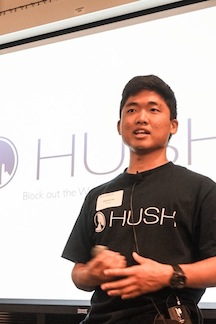
more than a year later, Lee and two other students at the Jacobs School of Engineering already have raised more than $450,000 through crowdfunding for their start-up company, Hush Technology. Their product? Smart wireless earplugs that block out external sounds but still allow users to hear their alarm clock and important messages via a smartphone app.
Lee, a mechanical engineering major, dreamed up the idea for the earplugs—which also double as a sound machine that plays white noise and ocean wave sounds—during Delson’s class. The class also provided him the tools to take his professional destiny in his own hands and start his own company, first at the Moxie Center for Student Entrepreneurship at UC San Diego and then at San Diego’s EvoNexus incubator. The devices will be manufactured here in San Diego.
Lee said he was inspired to develop the earplugs by his years of living in loud campus dorms and apartments shared with roommates. He and three other students built a prototype. When the class ended, the other students dropped out of the project, so Lee drafted his roommate, Daniel Synn, a structural engineering major, to help. A computer engineering student, also named Daniel Lee, but distinguished by his Korean first name, Chesong, joined the pair a few weeks later.
“Yes, our team has three Daniels,” they write on their website. “It’s impossible to make sense of group texts and email threads but we like it that way.”
The three engineering students divided up roles fairly quickly. Lee took charge of hardware and product development. He graduated in June 2014 to focus on Hush Technology full time. Chesong Lee focused on developing the app. Synn became the lead designer and chose to take a year off school to focus on the start-up. It took some convincing, but his family finally agreed to allow him to do so. Classes he took at the von Liebig Entrepreneurism Center at the Jacobs School were particularly helpful, he said. “They gave me a lot of vocabulary to talk the talk.”
— UC San Diego News Center
Personnel Moves
Robb Johnson Promoted at Marcus & Millichap
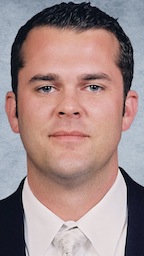
Marcus & Millichap, a commercial real estate investment services firm, has named Robb Johnson as associate vice president investments. Johnson was a senior associate of the firm. He began his career with Marcus & Millichap in October 2003, and was promoted to senior associate three years later. A retail investment professional, he specializes in negotiating single-tenant net-leased transactions on behalf of private and institutional investors in Southern California and across the country.

